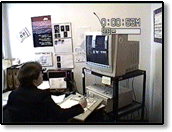|
Distance education: the way of the future
By Danica Patey and Greg Patey
Roncalli Central High
Port Saunders, Newfoundland |
|
In many schools across Canada, students are taking advantage
of a technology known as distance education.
"It is just learning over the Internet really,"
says Owen Penney, a student at Roncalli in Port Saunders. |

Owen Penney describes
distance education at
Roncalli view clip view clip |
A teacher is teaching the students from a different location.
His or her voice is carried through the phone lines and is receive
by the students through a voice box. The students can then respond
back to the teacher by talking into a microphone.
"It's just like a regular class," says Penney, "except
the teacher is in a different school."
At Roncalli, there are only two students and one teacher involved
in distance education this year. Owen Penney and Joseph Lowe
are both taking Physics 3204 through this method and Connie Powell
is teaching chemistry online. |
|
They have class ten times in a 14-day cycle, five online
classes and five offline classes, which provide the students
with time to do homework and to work on questions and assignments.
The online classes occur in a room off the science lab, where
students have access to all the required equipment. |
|
These students are very lucky to have distance education
available, since it is the only way the class could be taken
this year since few students wanted or required this course.
Penney suggests it would be beneficial for him to take this course
as well as it would provide a challenge for him.
Some advantages of taking distance education would be that
students would get the courses they need or want even if there
is no teacher at their school to teach it. That allows students
to fulfil university requirements for the given courses. |

Distance education in action at Roncalli.
 view
clip view
clip |
|
There are some disadvantages of distance education. For example,
it may be more difficult to learn without the one-on-one contact
with a teacher. Also, the problem with limited class time pops
up. Students have to do lab activities on their own and have
to work on assignments on their own. Everything is more independent.
"Distance Learning is a challenge for both the students
and teacher. The student has to be constantly reading ahead and
keeping up with assignments," says teacher Connie Powell.
"They have to be independent workers, which I feel, better
prepares them for the demand of a university education."
Distance education will prove to be the teaching of the future
with new technology and faster speeds. And in the future, the
number of teachers may be limited because of distance education.
This will be the way of the future. |
|